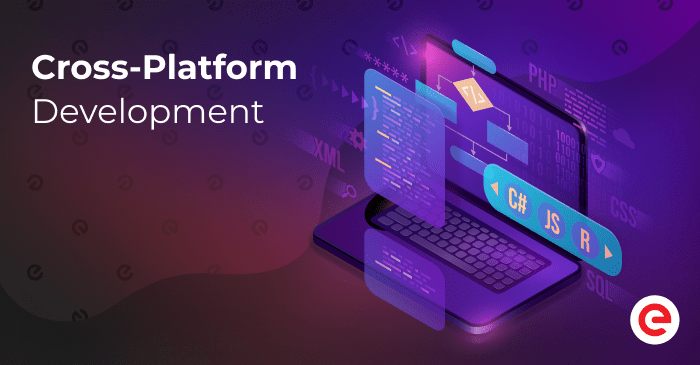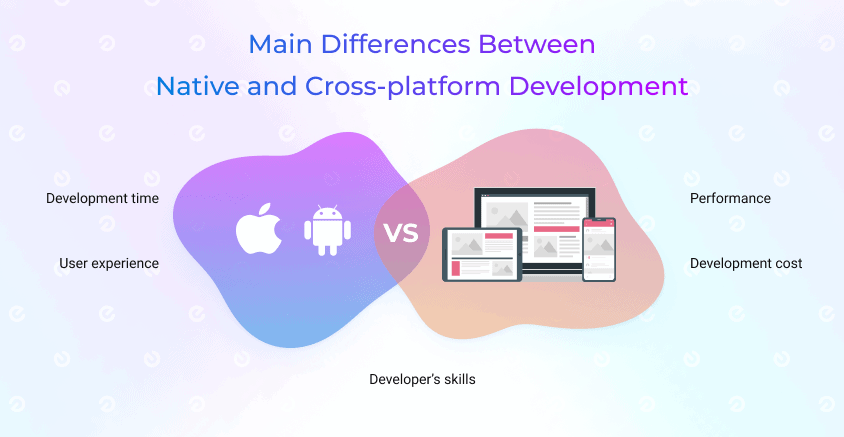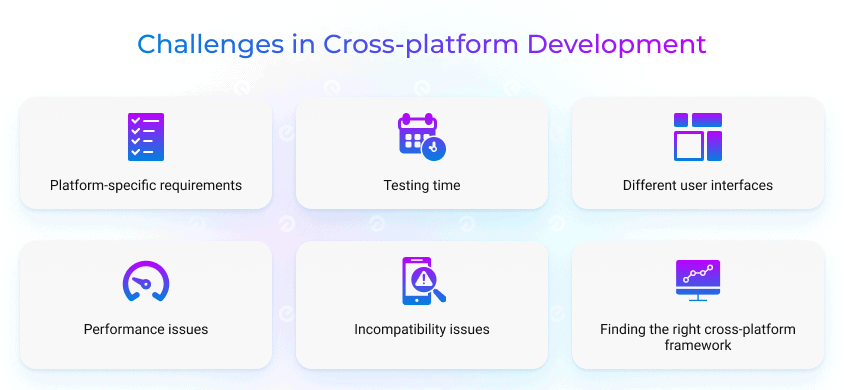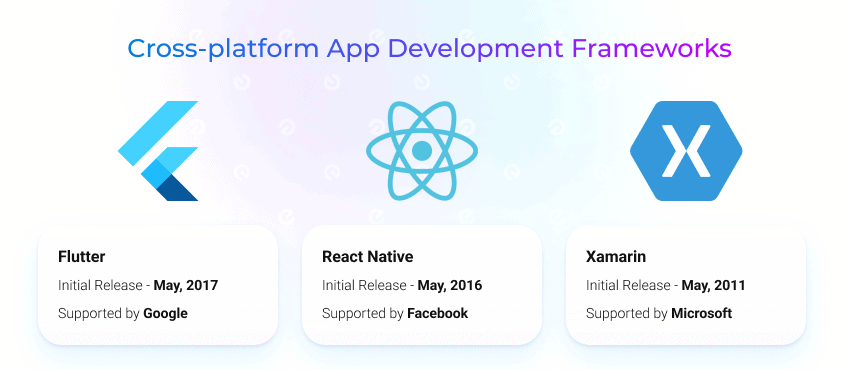
Updated: July 4, 2024
Published: February 27, 2023
The rapid growth of technology has led to an increased number of devices and platforms available to users. From smartphones and tablets to desktops and laptops, users have a wide range of devices to choose from, each with its own unique operating system and software environment. For businesses and developers, this presents a challenge: how do they ensure that their software works seamlessly across all these platforms? Cross-platform development provides a solution to this challenge by enabling developers to create applications that can run on multiple platforms.
List of the Content
- What is cross-platform development?
- Benefits of cross-platform development
- Difference between native and cross-platform development
- Challenges in cross-platform development
- Solutions to cross-platform development challenges
- Popular cross-platform frameworks
- How to start cross-platform development?
- Conclusion
WHAT IS CROSS-PLATFORM DEVELOPMENT?
In today’s technology-driven world, the need to develop software applications that can run on multiple platforms is on the rise. With the emergence of numerous operating systems and devices, developers need to create applications that can function across these different platforms. Cross-platform app development has become an essential requirement for software development companies, especially those that want to reach a broader audience.
It involves the process of creating software applications that can run on multiple operating systems and devices, such as Windows, macOS, iOS, Android, Linux, and more. In simpler terms, it refers to building software applications compatible with various platforms using a single codebase. This approach enables developers to create applications that can be used on different devices without having to rewrite the codebase for each platform.
The primary goal of cross-platform development is to increase the reach of software applications by enabling them to run on multiple platforms. This approach is cost-effective and saves time for developers, as they do not have to create separate versions of the application for each platform. Instead, they can use a single codebase that can be compiled to run on various platforms.
This development involves the use of frameworks, tools, and programming languages that are compatible with multiple platforms. These tools and frameworks allow developers to write code once and compile it to run on various platforms. It enables a common code base for the software. This approach can save time and resources, as developers do not have to create separate versions of the software for each platform. It is useful for building applications such as mobile apps, desktop apps, web applications, embedded apps, etc.
Cross-platform development is gaining popularity among software developers because it offers a range of benefits over traditional platform-specific development approaches. With a cross-platform approach, developers can reach a wider audience, save time and money, and ensure a consistent user experience across all platforms.
BENEFITS OF CROSS-PLATFORM DEVELOPMENT
This approach offers significant benefits, especially for businesses looking to maximize their resources and reach a wider audience with their applications. Let’s consider some of the main advantages of this development approach.
Increased efficiency
Cross-platform development enables developers to write code once and deploy it to multiple platforms, eliminating the need to create separate code for each platform. This approach significantly reduces development time and effort, enabling developers to focus on other aspects of software development, such as testing and quality assurance.
Reduced development time
Developing applications for multiple platforms can be a time-consuming and resource-intensive process. With cross-platform app development, developers can build applications faster and more efficiently, reducing the time to market. This approach enables developers to launch applications quickly, gain market share, and stay ahead of the competition.
Cost savings
It offers cost savings by reducing development time, effort, and resources required to create separate applications for each platform. This approach eliminates the need for separate development teams for each platform, enabling companies to save on development costs. Additionally, development tools often offer cost-effective licensing models, making them an attractive option for businesses of all sizes.
Consistent user experience
Cross-platform development ensures the consistent user experience across all platforms. By using a single codebase, developers can create applications with the same look and feel across all devices and platforms, eliminating the need to create separate user interfaces for each platform. This approach ensures that users have a consistent and intuitive experience, regardless of the device they are using.
Easier maintenance and updating
Maintaining and updating applications for multiple platforms can be a challenging task. Cross-platform app development enables developers to make updates and changes to a single codebase, ensuring that all platforms are updated simultaneously. This approach significantly reduces the effort required to maintain and update applications, improving the overall efficiency of the development process.
Wider audience reach
Cross-platform application development enables developers to reach a wider audience by making their applications accessible across multiple platforms. This approach enables businesses to reach users on different devices and platforms, expanding their market reach and increasing revenue potential.
Improved collaboration and communication
It enables improved collaboration and communication among development teams. With a single codebase, teams can work more efficiently, share code and resources, and ensure that all team members work towards the same goal. This approach eliminates the need for separate teams for each platform, reducing communication gaps and ensuring that team members are on the same page.
Better performance
The development tools are continuously improving, with many offering features that enable developers to optimize the performance of their applications. With cross-platform development, developers can optimize their applications to ensure they run smoothly and efficiently on all platforms. This approach enables developers to create high-performing applications that deliver a better user experience, improving customer satisfaction and loyalty.
DIFFERENCE BETWEEN NATIVE AND CROSS-PLATFORM DEVELOPMENT
The next step is to compare two common approaches to creating software applications for different platforms. We will figure out the main differences and find useful tips on making the final decision for your projects.
Native development is focused on creating an application that is optimized for a specific platform, while cross-platform app development is focused on creating an application that can run on multiple platforms with a single codebase. The choice of which approach to use depends on the specific project needs and requirements.
While both native and cross-platform development have their advantages, they also have their differences. The following are some key differences between native and cross-platform app development:
- Development time: Development time is another crucial factor to consider. If time is of the essence, cross-platform app development may be the better choice as it saves developers a significant amount of time by allowing them to write code once and deploy it on multiple platforms.
- Performance: Native applications are often considered faster and more optimized for the platform as they are written in their native language. On the other hand, cross-platform development has considerably advanced over recent years. Thus, today’s cross-platform apps don’t compromise on speed or quality at all.
- User experience: Native applications can offer a great user experience as they can leverage the unique features of the platform. Cross-platform applications, while providing a consistent user experience, also take full advantage of the platform’s features.
- Cost: Cross-platform app development can be more cost-effective as it saves developers time and resources. Native development, however, can be more expensive due to the need to create separate codes for each platform.
- Skills: Native development requires specific skills for each platform, such as Java or Kotlin for Android and Swift or Objective-C for iOS. Cross-platform frameworks like React Native and Flutter use web technologies like JavaScript and Dart, making them more accessible to developers with custom web application development experience.
When choosing between native and cross-platform development, there are several factors to consider. The following are some factors to focus on:
Development time: Development time is another crucial factor to consider. If time is of the essence, cross-platform app development may be the better choice as it can save developers a significant amount of time by allowing them to write code once and deploy it on multiple platforms.
Application requirements: The application requirements can significantly influence the choice between native and cross-platform development. If the application requires access to specific hardware features or unique platform features, native development may be the better choice. The cross-platform approach, on the other hand, may be the better choice if the application does not require access to unique platform features and needs to be deployed on multiple platforms.
Budget: Budget is another important factor to consider. If budget is a concern, cross-platform development may be the better choice as it can save developers time and resources, reducing the overall development costs.
Target audience: The target audience can also influence the choice between native and cross-platform app development. For instance, if the target audience is primarily iOS users, native development may be the better choice as it can leverage the unique features of the iOS platform, providing a great user experience. However, if the target audience is spread across multiple platforms, cross-platform solutions would be the right choice.
CHALLENGES IN CROSS-PLATFORM DEVELOPMENT
Cross-platform development offers many benefits, such as reduced development time, lower costs, and a broader reach. However, there are several challenges that developers might face when building cross-platform applications.
Platform-specific requirements
One of the biggest challenges in cross-platform app development is dealing with platform-specific requirements. Different platforms have their own unique features and capabilities, and developing an application that can run on all platforms requires compromising on some of these features.
For example, iOS has strict guidelines for user interface design, while Android offers more flexibility. Developers must ensure that their application meets the guidelines of all platforms they intend to deploy the application. This can be challenging as it requires knowledge of the different platforms and their guidelines.
Different user interfaces
Another significant challenge is dealing with different user interfaces. Different platforms have different user interfaces, and developers must ensure that their application looks and feels the same across all platforms.
This can be challenging, as the design and layout of an application can vary significantly across different platforms. Developers must ensure that the application’s user interface is consistent across all platforms to provide a seamless user experience.
Incompatibility issues
Cross-platform frameworks use a single codebase to build applications for different platforms, which can lead to incompatibility issues between the different platforms.
For example, a feature that works seamlessly on one platform may not work on another platform due to differences in the platforms’ architecture. Developers must ensure that their application is tested thoroughly on all platforms to identify and fix any incompatibility issues.
Performance issues
To ensure optimal performance, developers must optimize their codebase for each platform. This can be challenging as it requires knowledge of the different platforms and their hardware specifications. Additionally, optimizing for one platform may negatively impact the performance of another platform, requiring developers to find a balance between performance and cross-platform compatibility.
Testing time
Another challenge in cross-platform development is the additional development and testing time required. Building an application that can run on multiple platforms requires more development and testing time than building a platform-specific application.
Developers must ensure that their application is thoroughly tested on all platforms to identify and fix any issues. This can be time-consuming, especially when working with complex applications.
Finding the right cross-platform framework
Choosing the right cross-platform framework is another challenge in cross-platform app development. With so many frameworks available, each with its own set of advantages and disadvantages, it can be challenging to find the right framework for a particular project.
Developers must consider factors such as the framework’s performance, the level of code sharing, the ease of use, and the availability of community support when choosing a cross-platform framework.
SOLUTIONS TO CROSS-PLATFORM DEVELOPMENT CHALLENGES
While this development approach presents several challenges, there are effective solutions that developers can use to overcome them.
Embracing native look and feel
To overcome the challenge of different user interfaces, developers can embrace the native look and feel of each platform. This involves designing the user interface to look and feel like a native application on each platform.
Developers can use platform-specific design guidelines to ensure that the application’s user interface is consistent across all platforms. This approach can provide a seamless user experience, making the application feel like a native application on each platform.
Want to learn more about UI/UX design and its latest trends?
We recommend reading our latest article on mobile application UI/UX design. It includes a comprehensive guide covering the design principles, process, available tools, etc.
Optimizing performance
To overcome performance issues, developers can optimize their codebase for each platform. This involves identifying and addressing any bottlenecks in the code that could negatively impact performance.
Developers can use profiling tools to identify performance issues and optimize the code accordingly. Additionally, developers can use platform-specific features to improve performance, such as using hardware acceleration on mobile devices.
Code sharing
Code sharing is another solution to overcome the challenges of cross-platform development. Cross-platform frameworks provide a set of tools and libraries that allow developers to write a single codebase that can be compiled for different platforms.
Developers can use code sharing to reduce development time and costs while ensuring that their application runs seamlessly on all platforms. However, it is essential to ensure that the codebase is optimized for each platform to avoid performance issues.
Using the right cross-platform framework
Choosing the right cross-platform framework is crucial in overcoming the challenges of cross-platform app development. Developers must consider factors such as the framework’s performance, the level of code sharing, the ease of use, and the availability of community support when choosing a cross-platform framework.
Developers should also consider the requirements of their project, such as the target platforms, application complexity, and development time when choosing a framework.
Cross-platform development offers solutions to the challenges of developing applications that can run seamlessly on multiple platforms.
CROSS-PLATFORM APP DEVELOPMENT FRAMEWORKS
It has become a hot topic among developers in recent years. With the growth of mobile applications, developers have been looking for ways to create applications that can work on multiple platforms, including Android, iOS, and web applications. This has led to the creation of various cross-platform frameworks that allow developers to create applications that can run on multiple platforms with a single codebase.
These frameworks have many benefits, including reduced development time, cost savings, and easier maintenance. Flutter, React Native, and Xamarin are some of the most popular cross-platform frameworks used today.
Flutter
Flutter is an open-source framework developed by Google for creating high-performance, advanced apps for iOS and Android from a single codebase. Flutter was launched in 2017, and since then, it has gained popularity among developers for its fast development, expressive and flexible UI, and ease of use.
Flutter uses the Dart programming language, which is easy to learn and offers great performance. One of the key benefits of Flutter is that it offers a rich set of customizable widgets used to create stunning user interfaces. Flutter’s hot reload feature enables developers to make changes to the code and see the results instantly, making development faster and more efficient.
Another significant advantage of Flutter is its ability to create native-like experiences on Android, iOS, and web platforms. Flutter uses its own rendering engine to create user interfaces, which allows it to deliver consistent and high-performance UI across both platforms.
React Native
React Native is a cross-platform mobile app development framework developed by Facebook. It allows developers to create native applications for Android and iOS platforms with a single codebase. React Native uses the popular React framework to build user interfaces, which allows developers to use the same code for mobile and web app development services.
React Native provides a rich set of components that can be used to create interactive and responsive user interfaces. It also supports hot reloading, which makes development faster and more efficient. React Native’s code-sharing feature enables developers to write code once and reuse it within multiple platforms, saving development time and reducing costs.
Xamarin
Xamarin is a cross-platform app development framework that uses C# programming language to create mobile applications for Android, iOS, and Windows platforms. Xamarin was acquired by Microsoft in 2016, which has helped to increase its popularity among developers.
Xamarin provides a rich set of components that can be used to create user interfaces. It also provides access to platform-specific APIs, which allows developers to integrate native functionality into their applications. Xamarin also supports hot reloading, which makes development faster and more efficient.
Xamarin also allows developers to use their existing C# code, libraries, and tools, which makes it easier to migrate existing applications to cross-platform development. Additionally, Xamarin provides integration with Visual Studio, which is a popular IDE used by many developers.
Looking for more information about these cross-platform frameworks?
Read the detailed guide on the best development practices and popular frameworks for app development.
All three frameworks have large and active communities that are continuously developing new plugins and libraries, making it easier for developers to integrate various functionalities into their applications. Additionally, all three frameworks have rich sets of documentation and tutorials, making it easy for developers to learn and use.
Choosing a cross-platform framework depends on the specific needs of the project, the skillset of the development team, and the desired user experience. Developers should evaluate the features and capabilities of each framework and choose the one that best suits their needs.
HOW TO START CROSS-PLATFORM DEVELOPMENT?
Let’s consider a few more aspects to help you get started with cross-platform app development. Regardless of your project specifications, the team usually follows such steps.
- Identify your goals: Before you begin, you should have a clear idea of what to accomplish with the cross-platform approach. Consider what platforms you want to target, what features you want to include in your application, and what your budget and time constraints are.
- Choose a development tool or framework: There are many development tools and frameworks available, such as React Native, Xamarin, Flutter, and others. Each tool has its strengths and weaknesses; thus, it’s important to choose one that is best suited to your needs. Consider factors such as development language, community support, and ease of use when making your choice.
- Setup your development environment: Once you have chosen a development tool, set up your development environment for cross-platform development. This may include installing software such as an integrated development environment (IDE), a code editor, and any necessary libraries or tools. Ensure your development environment supports all the platforms you want to target.
- Plan your application architecture: Before you start coding, take some time to plan your application architecture. Identify the key features and functionality that you want to include in your application and design the application architecture accordingly. Consider factors such as data storage, user interface, and platform-specific functionality.
- Write your code: Once you have a clear plan in place, start writing your code. Use the chosen development framework and write platform-specific code as required. Make sure that your code is well-organized, readable, and efficient.
- Test your application: Once you have written your code, it’s time to test your application. Test it on all the platforms you want to target to ensure that it functions properly. Consider using automated testing tools to help streamline the testing process.
- Optimize your application: After you have tested your application, you may need to optimize it to ensure that it runs smoothly on all platforms. This may involve optimizing performance, memory usage, and user experience. Consider using profiling tools to identify areas of your code that need optimization.
- Publish your application: Once your application is complete, it’s time to publish it. Publish your application to the various app stores for each platform you want to target. Make sure to follow the guidelines for each app store and optimize your application for each platform.
By following these steps, you can get started with cross-platform development and create applications that can run on multiple platforms. With the right tools and efficient approaches, that became a highly rewarding experience.
CONCLUSION
Cross-platform development has become a popular trend in the software development industry, and it is expected to continue growing in popularity. With the vast number of mobile devices available in the market, it is essential for developers to leverage this approach to create applications that work seamlessly across different platforms. As technology continues to evolve, cross-platform app development will undoubtedly play an essential role in the software development industry.
Have you thought about developing a cross-platform application?
Existek is a software development company with first-hand experience in cross-platform development. You can contact our team of experts for professional consultation and further assistance with your questions.
Frequently asked questions
What is cross-platform development?
It is the practice of creating software applications that can run on multiple operating systems. That means developers can create a single application deployed on multiple platforms rather than developing a separate one for each platform.
Why choose cross-platform application development for your projects?
This development approach has opened many distinct opportunities for businesses and developers. The main advantages include the following:
Increased efficiency
Reduced development time
Cost savings
Consistent user experience
Easier maintenance and updating
Wider audience reach
Improved collaboration and communication
Better performance
What are the main solutions to cross-platform challenges?
The most effective solutions depend on
Embracing native look and feel
Optimizing performance
Code sharing
Using the right cross-platform framework
What are the most popular cross-platform frameworks?
Cross-platform tools and frameworks have greatly gained in popularity over recent years. The top market positions belong to:
Flutter
React Native
Xamarin





